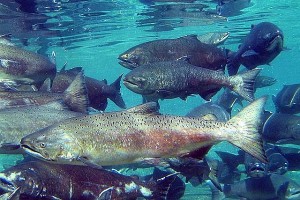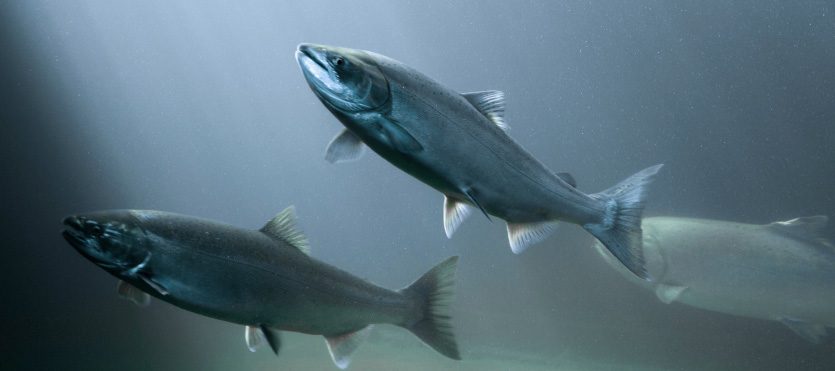Restoring Natural Habitat & Salmon
Restoring Natural Habitat & Salmon
Salmon and the Chehalis Watershed
 Salmon in the Chehalis Basin have a strong cultural and economic significance to the people who reside here. These fish were once abundant, but are now seriously degraded from historic levels. Experts estimate that the current abundance of the Chehalis Basin’s Spring Chinook salmon runs are 20% of what they were just 100 years ago, and other species are less than 50%. Leading to this decline have been overfishing, diking and draining of estuaries, wetlands and floodplains, a vast network of road and rail systems built with inadequate fish passage, and unregulated timber harvest, industrial, and residential development. In order to slow and reverse the decline of the salmon populations, the Pacific Salmon Recovery Fund and the Lead Entity process were initiated in Washington State’s rivers. The Chehalis Lead Entity consists of experts from state, local, and tribal governments, as well as the Regional Fisheries Enhancement Group and interested local citizens. Our mission is to identify and then collaboratively evaluate voluntary restoration and protection actions that create healthy habitat for salmonids.
Salmon in the Chehalis Basin have a strong cultural and economic significance to the people who reside here. These fish were once abundant, but are now seriously degraded from historic levels. Experts estimate that the current abundance of the Chehalis Basin’s Spring Chinook salmon runs are 20% of what they were just 100 years ago, and other species are less than 50%. Leading to this decline have been overfishing, diking and draining of estuaries, wetlands and floodplains, a vast network of road and rail systems built with inadequate fish passage, and unregulated timber harvest, industrial, and residential development. In order to slow and reverse the decline of the salmon populations, the Pacific Salmon Recovery Fund and the Lead Entity process were initiated in Washington State’s rivers. The Chehalis Lead Entity consists of experts from state, local, and tribal governments, as well as the Regional Fisheries Enhancement Group and interested local citizens. Our mission is to identify and then collaboratively evaluate voluntary restoration and protection actions that create healthy habitat for salmonids.
Unlike other river systems in the state, salmon in the Chehalis River are not listed as Endangered. In the Chehalis River Basin, we still have the chance to protect this iconic species. By implementing on-the-ground salmon recovery projects, the people of the Chehalis Basin are recovering habitat, restoring fish populations, improving watershed health, and thereby supporting the cultural, social and economic needs of human communities.

A Strategy for Salmon Recovery
Salmon have been adversely affected by many different activities that have happened throughout the landscape over time. We can’t reverse these changes, but we can improve “habitat forming processes” that create good habitat for fish. Given the complexity needed to address habitat degradation, strategic planning is needed to figure out what to focus on in order to best recover wild salmon stocks. In 2011, the Chehalis Lead Entity released a strategy that includes seven priority approaches for recovering salmon.
- Attain a Healthy and Diverse Population of Wild Salmonids Diversity can only be maintained if all species of salmon in the Chehalis survive and thrive. This means we need to support the species most likely to go extinct without our help (wild salmon stocks that are listed as “depressed”, “threatened” or “endangered”).
- Restore, Enhance, and Protect the Grays Harbor Estuary The Chehalis River flows into the Grays Harbor estuary, a saline bay that is rearing habitat for many types of wild salmonids. Maintaining this “salmon nursery” will take addressing the loss of shoreline habitat and degraded water quality in Grays Harbor.
- Restore and Preserve Properly Functioning Riparian Areas Riparian areas- the zone between land and water- are critical for salmon survival. Restoring and preserving these area starts with assisting landowners to reduce the impacts of their livestock, and assisting forestry operators to address the legacy of poor forestry practices around creeks.
- Restore Habitat Access Undersized culverts on public and private lands create a barrier to salmonids attempting to migrate between to spawning grounds and the sea. There are over 2,700 documented barrier culverts in the Chehalis. Replacing dysfunctional culverts in order to allow salmon passage is a high priority throughout the Chehalis Watershed.
- Restore Properly Functioning Hydrology Ditching, filling and armoring streambanks has led to extremes of high flows in the winter and low flows in the summer, as well as downstream flooding and excessive bank erosion. Reversing these alterations to streamflow will help improve wild salmon habitat.
- Restore Floodplain and Stream Channel Function Floodplains provide fish with habitat for feeding, spawning and rearing, as well as refuge from high velocity flood waters. Levees, dikes, revetments and roads have disconnected valuable floodplains, off-channel habitat, wetlands and sloughs. Projects that restore floodplain function are a major priority in the Chehalis Basin.
- Prioritize Habitat Projects and Activities within Sub-basins That Provide the Highest Benefit to Priority Stocks Since funding is limited, the Lead Entity needs to work to find projects that have the highest potential for yielding the greatest benefit to priority salmon stocks.
See Documents for the full text of the Strategy.
